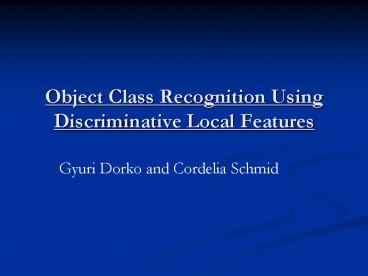Object Class Recognition Using Discriminative Local Features - PowerPoint PPT Presentation
Title:
Object Class Recognition Using Discriminative Local Features
Description:
Object Class Recognition Using Discriminative Local Features Gyuri Dorko and Cordelia Schmid Introduction This method is a two step approach to develop a ... – PowerPoint PPT presentation
Number of Views:187
Avg rating:3.0/5.0
Title: Object Class Recognition Using Discriminative Local Features
1
Object Class Recognition UsingDiscriminative
Local Features
- Gyuri Dorko and Cordelia Schmid
2
Introduction
- This method is a two step approach to develop a
discriminative feature selection for object part
recognition and detection. - The first step extracts scale and affine
invariant local features. - The second generates and trains a model using the
features in a weakly supervised approach.
3
Local Descriptors
- Detectors
- Harris-Laplace
- Harris-Affine
- Entropy (Kadir Brady)
- Descriptors
- SIFT (Scale Invariant Feature Transform)
4
Learning
- This is also a two step process
- Part Classifier
- EM clustering in the descriptor space
- Part Selection
- Ranking by classification likelihood
- Ranking by mutual information criterion
5
Learning the part classifiers
With the clustering set positive descriptors are
obtained to estimate a Gaussian Mixture Model
(GMM). It is a parametric estimation of the of
the probability distribution of the local
descriptors.
Where K is the number of Gaussian components and
The dimension of the vectors x is 128
corresponding to the dimensions of the SIFT
features.
6
Learning the part classifiers
The model parameters mi, Si and P(Ci) are
computed with the expectation-maximization (EM)
algorithm. The EM is initialized with the output
of the K-means algorithm. This are the equations
to update the parameters at the jth maximization
(M) step.
7
Learning the part classifiers
The clusters are obtained from assigning each
descriptor to its closest component. The clusters
typically contain representative object parts or
textures.
Here we see some characteristic clusters of each
database. With the mixture model a boundary is
defined for each component to form K part
classifiers. Each classifier is associated with
one Gaussian
A test feature y is assigned to the component i
having the highest probability.
8
Selection
- The selection ranks the components according to
its ability to discriminate between the
object-class and the background. - By classification likelihood. Promotes having
high true positives and low false positives. - By mutual information. Selects part classifiers
based on the information content to separate
background from the objects-class.
9
Ranking by classification likelihood
- The ranking is computed as follows
Where V(u) and V(n) are the unlabeled
(potentially positive) descriptors vj(u) and
negative descriptors vj(n) from the validation
set. Performs selection by classification rate.
This component hay have very low recall rates.
Even though this parts are individually rare,
combinations of them provide sufficient recall
with excellent precision. Recall true
features/(true features true negatives)
10
Ranking by mutual information
- Best to select a few discriminative general part
classifiers. - Ranks parts classifiers based on their
information content for separating the background
from the object-class. - The mutual information of component Ci and
object-class O is
Naively assumes all unlabeled as the object
11
Final feature Classifier
- Based on the ranking, the n part classifiers of
the highest rank are chosen and marked as
positive. - The rest are marked as negative, the true
negative and the non-discriminative positive
ones. - Note that each part classifier is based on a
Gaussian component, thus the MAP criterion only
activates one part classifier per descriptor.
12
Applications
- Initial step for localization within images. The
output is not binary but a ranking of the part
classification. - Classification of the presence or absence of an
object in an image. Here is required an
additional criterion of how many p positive
classified descriptors are required to mark the
presence of an object. The authors uses this
because it is easier to compare.
13
Experimental Results
Feature selection with increasing n
Precision by detector and ranking
14
Experimental Results
ROC (Receiver Operating Characteristic)
True positives on equal-error rate
15
Experimental Results
16
Experimental Results
Selection of the entropy detector
Selection results of different feature detectors
17
Thanks!































